Tips For Garden Sharing: How To Start A Shared Garden


Community gardens continue to grow in popularity throughout the country and elsewhere. There are lots of reasons to share a garden with a friend, neighbor, or a group of the same. Usually, the bottom line is getting fresh and often organic produce to feed your family, but not always.
Flowering gardens are sometimes shared across a property line, improving the appearance of more than one landscape. Perhaps, you’re growing a cutting garden with plenty of blooms to supply fresh flowers for two households. While most garden sharing is for the food, keep in mind there are other reasons too.
What is a Shared Garden?
Communal gardening may spring from a community garden or simply from sharing and working a plot of land with one or more neighbors. A long-term joint garden may result in fruit and nut trees that produce heavily after a few years, saving you money at the grocery store. As you may know, gardening is great exercise and can provide a sense of community and belonging.
Even if you just grow vegetables that complete their life cycle within a few months, you can get lots of healthy produce from a relatively short growing season. Why would you get involved in such a collaboration? Again, the reasons are numerous.
Maybe your neighbor has an excellent garden plot laid out that requires just a few amendments, while your own yard does not even have a good, sunny spot. Maybe your yard is too small to add a garden of any size, or you don’t want to disturb a nice lawn. With the right planning, sharing a garden can easily provide enough food for two families.
How to Start a Shared Garden
Depending on your area, you may be able to grow food for several months of the year or even year-round. If you’re growing with one other, or just a few, take the time to lay out a planting schedule with foods you both like and will use.
Include herbs for everyone. If you have a general idea of how much each family will use, plant enough for both, with a little extra. Remember to include succession planting for favorite crops.
Sign up for the Gardening Know How newsletter today and receive a free copy of our e-book "How to Grow Delicious Tomatoes".
Discuss and agree before getting started on what will be planted. Divide the responsibilities evenly so you know who will be in charge of what task. Agree ahead of time on what type of pest control will be used.
Take stock of tools, what you have, and any you may need to purchase. Include where and when they’ll be stored.
Share in the harvesting and split the surplus as previously agreed. You may even have extras that can be divvied and shared with others. Work together to clean up the garden spot well following the harvest.
Stay involved and in constant communication. If things should change, like with the addition of more plants, a new design, or even the inability to perform tasks as planned, you’ll want to discuss these changes and alter them as needed.

Becca Badgett was a regular contributor to Gardening Know How for ten years. Co-author of the book How to Grow an EMERGENCY Garden, Becca specializes in succulent and cactus gardening.